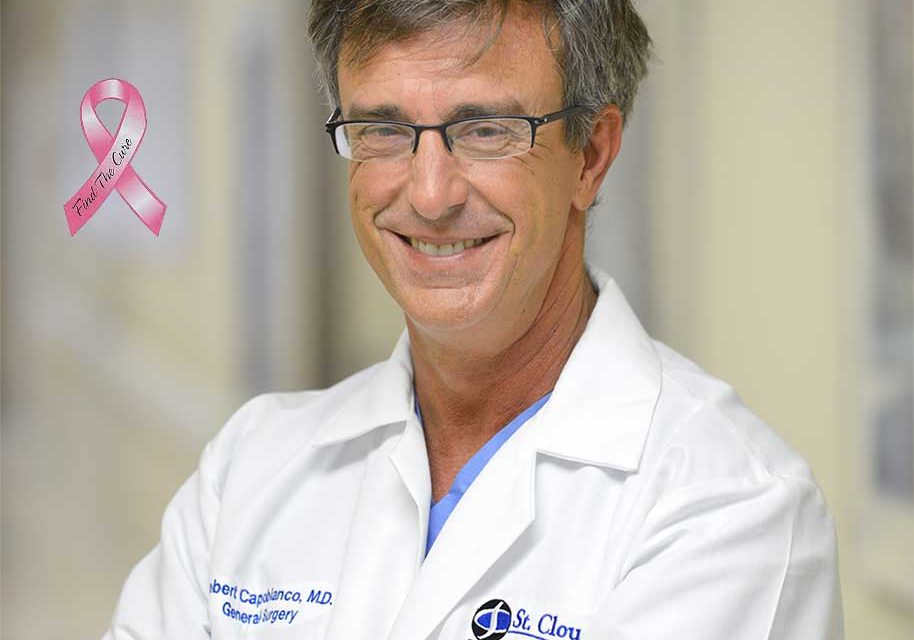By Robert Capobianco, MD, board-certified general surgeon with St. Cloud Medical Group.
Breast cancer is a pervasive, highly publicized and very personal disease. Most everyone has a mother, sister, relative or friend who has had a brush with breast cancer – a scare, a survival story, or the memory of a loved one who succumbed to it.
Breast cancer is a pervasive, highly publicized and very personal disease. Most everyone has a mother, sister, relative or friend who has had a brush with breast cancer – a scare, a survival story, or the memory of a loved one who succumbed to it. According to the American Cancer Society, breast cancer is the second most common cancer among women, other than skin cancer. It’s estimated that more than 192,000 women will be diagnosed with breast cancer during 2009.
Regular clinical breast exams and mammograms are the first line of defense for all adult women to monitor their breast health and follow up on any changes that their doctor may notice such as lumps, bumps, pain and tenderness, or unusual discharge. Certain changes in the breast tissue are normal and more common as women age, but any unusual symptoms should be shared with your doctor to make sure they are not cancer. Though the value and diagnostic capabilities of breast self-exams (BSE) have been debated both in health care circles and the media, it’s agreed that a thorough knowledge of the normal look and feel of one’s breasts can help detect any obvious changes.
Research from the Mayo Clinic states that eight of every 10 breast lumps are not cancerous. And, according to the American Cancer Society, the most common physical changes in the breasts – lumps, tenderness or discharge – are usually linked to benign conditions, i.e., conditions that do not lead to cancer. The most common diagnoses related to a breast lump, says the ACS, include fibroadenoma (a benign solid tumor), fibrocystic changes (benign breast changes), atypical hyperplasia (fast-growing abnormal cells), cysts (benign, fluid-filled sacs), or non-invasive cancers, such as ductal carcinoma in situ (DCIS) – a cancer of the milk ducts.
A lump or cyst may be detected by a woman during a BSE or by her doctor during a clinical exam. A lump that is also tender and warm to the touch is likely a breast infection. A cyst is a round or an oval mass, can move when touched, and is full of fluid. Found in about one in three women between ages 35 and 50, cysts are diagnosed by a breast ultrasound or biopsy. Other breast changes are not visible to the eye and show up during a mammogram, an X-ray that takes a picture of the breast tissue and can detect tumors before they are big enough for your doctor to feel. Beginning at age 40, women should have a screening mammogram once a year – and more often if there is a genetic predisposition toward breast cancer or a breast condition that warrants close follow-up.
A call from your doctor after a mammogram can be a worrisome experience. In most cases, the area in question turns out to be benign. About one in 10 women who get a mammogram will need more pictures taken – but most of these are not malignant or cancerous. Only two to four of every 1,000 mammograms lead to a diagnosis of cancer, according to the ACS.
Common mammogram findings include calcifications, a mass, fibrosis or lipoma. Some of these conditions can indicate the possibility of cancer, and others are completely benign. Your physician will recommend further testing, if needed. Calcifications – tiny mineral deposits in the breast tissue – show up as white flecks on your mammogram film. There are two types: macrocalcifications, which are larger deposits generally caused by aging, injury or inflammation; and microcalcifications, tiny specs of calcium in the breast tissue, scattered or in clusters. The pattern and number of these deposits will help your doctor make a determination about whether cancer is present.
A mass may or may not be cancerous. The size, shape and borders of a mass help to define whether it is benign or malignant. Fibrosis refers to the presence of fibrous tissue, a thickened area similar to scar tissue, which may be tender. Fibrocystic changes do not increase the chance for breast cancer, and any discomfort can be treated with over-the-counter pain relievers or diet changes, such as limiting caffeine. Fibroadenomas, are benign tumors made of both connective tissue and breast tissue. They are more common in younger women under age 40, are round and well defined, painless, and move. Another benign tumor is a lipoma, or fatty tumor, which is not tender and can occur anywhere.
Most benign breast conditions do not raise your risk of developing breast cancer. Depending on your diagnosis, your doctor may wish to perform imaging tests such as an ultrasound or MRI, or more frequent mammograms to keep a close eye on your health.
To set up a screening mammogram, call 407-498-3707 or visit StCloudRegional.com for more information on women’s health services. If you should need additional care after the screening mammogram results, call 407-498-3763 to reach the office of St. Cloud Medical Group Surgical & Vascular Services which specializes in women’s breast health procedures.




















